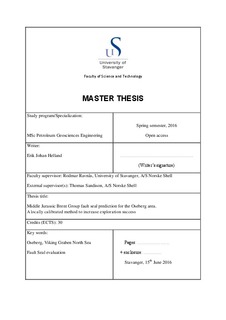| dc.contributor.advisor | Ravnås, Rodmar | |
| dc.contributor.author | Helland, Erik Johan | |
| dc.date.accessioned | 2016-10-12T13:48:52Z | |
| dc.date.available | 2016-10-12T13:48:52Z | |
| dc.date.issued | 2016-06-15 | |
| dc.identifier.uri | http://hdl.handle.net/11250/2414747 | |
| dc.description | Master's thesis in Petroleum geosciences engineering | nb_NO |
| dc.description.abstract | This thesis provide a case-study of fault-seal characteristics and consequently the retained hydrocarbon column heights in the Oseberg area. The interpretation of the Oseberg structure utilized seismic and well data to map and characterize the main structural elements and key lithostratigraphic intervals. Along with fault-seal calculations, an evaluation of the Shell developed proprietary Stochastic Trap Analysis and Risking tool (STAR) and its applicability to the Brent Group was carried out. Additionally, this case study provides an assessment of the methodology applied to the construction of a coherent structural and property model with facies distribution by highlighting weaknesses and strengths of each singular process and its ultimate impact on the quality of the end product.
Fristad et al. (1997) previously conducted a similar case study of the fault-sealing potential in the Oseberg area calibrated to well data, and concluded that for Brent level reservoirs in the Oseberg field, sealing faults exhibit typical ranges of SGR (Shale Gauge Ratio). Fristad et al. (1997) found that SGR values of <15 % do not hydraulically isolate structures, SGR in the range 15 % - 18 % support minor pressure differences (<1-2 bar) and that SGR values of >18 % corresponds to significant fault sealing (> 8 bar). This thesis provides comparison to Fristad et al. (1997) and ultimately addresses whether the analogue dataset used to determine limiting SGR values in the STAR tool is applicable. The STAR tool operates with a global database based on analogues from the Niger Delta, Oman, Brunel, GOM, DW Brazil, and the Central and Southern North Sea. Based on this dataset, STAR has predetermined probabilistic column heights associated with specific SGR values. After correlating the SGR calculations in this thesis with cross-fault formation pressure surveys, it was found that faults classified as sealing indicate that higher SGR values (>30 %) can support hydrostatic pressure differences of >8 bar. It was also found that faults displaying SGR values between 24 % and 30 % can be linked with minor cross fault pressure differences of around <1-4 bars. SGR zones displaying values < 24 % are found to be acting as conduits for cross-fault fluid communication between some structural segments. Finally, by applying these SGR calculations, even the P(10) case from STAR underestimate the retained column heights in the defined structural elements in the Oseberg area. As a result, is can be argued that STAR needs to be recalibrated to the specific components and parameters that we see in the Brent Group to be better suited in predictive analysis and fault seal evaluation in the northern North Sea if future opportunities are not to be missed. | |
| dc.language.iso | eng | nb_NO |
| dc.publisher | University of Stavanger, Norway | nb_NO |
| dc.relation.ispartofseries | Masteroppgave/UIS-TN-IPT/2016; | |
| dc.rights | Navngivelse 3.0 Norge | * |
| dc.rights.uri | http://creativecommons.org/licenses/by/3.0/no/ | * |
| dc.subject | petroleum engineering | nb_NO |
| dc.subject | petroleumsgeologi | nb_NO |
| dc.subject | petroleum geosciences engineering | nb_NO |
| dc.subject | fault seal evaluation | nb_NO |
| dc.title | Middle Jurassic Brent Group fault seal prediction Oseberg | nb_NO |
| dc.type | Master thesis | nb_NO |
| dc.subject.nsi | VDP::Technology: 500::Rock and petroleum disciplines: 510::Geological engineering: 513 | nb_NO |

